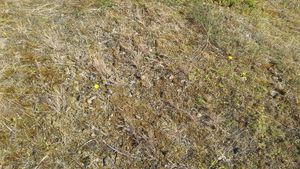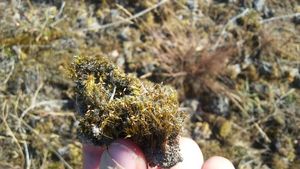Info page Campylopus introflexus (Heath star moss)
What does Campylopus introflexus look like?
Heath star moss (Campylopus introflexus) belongs to the deciduous moss family and is divided into stems and leaflets. The plants grow to a height of 0.5 to 5 cm and grow in mats or form a dense turf. The leaflets are 4 to 6 mm long, lanceolate and have a yellowish to olive-green colour. The tips of the leaves have the eponymous glass hairs. These bend 90° when dry and give Campylopus introflexus its typical and unmistakable appearance.
 Figure 1: Campylopus introflexus mat on a dune on Spiekeroog (Photo: Prinz July 2018)
Figure 1: Campylopus introflexus mat on a dune on Spiekeroog (Photo: Prinz July 2018)
 Figure 2: Close-up of Campylopus introflexus (Photo: Prinz July 2018)
Figure 2: Close-up of Campylopus introflexus (Photo: Prinz July 2018)
Where does Campylopus introflexus originally come from? Where is it found?
The natural distribution areas are South America, Africa, Australia, the Pacific islands and sub-Antarctic regions. It has been found in Europe since the middle of the last century and has been spreading across the continent ever since.
In Germany, Campylopus introflexus has spread from the west and now colonises the entire North Sea coast, with a focus on the West and East Frisian Islands and the Baltic coast. In addition to occurrences on coastal dunes, it can also be found inland, so that the species now occurs in all German Federal States. The moss has been documented on the East Frisian Islands since 1970 and was found on Borkum, Juist, Norderney, Baltrum, Langeoog, Spiekeroog and Wangerooge in 2001 and 2002.
Campylopus introflexus is a pioneer and colonises open, semi-natural and anthropogenic sites. The sites are mostly dry, acidic sandy soils, such as silver grass meadows of coastal dunes, dwarf shrub heaths and open sandy areas. On the North Sea coast, Campylopus introflexus occurs on soils with a pH value between approx. 4.5 and 6.2.
How does Campylopus introflexus spread?
Campylopus introflexus is rarely found with sporophytes in Germany, which means that sexual reproduction does not usually take place. It spreads mainly vegetatively by breaking off parts of the plant, from which new plants develop. This moss belongs to the alternately moist plants, which are also called poikilohydric plants. These plants are characterised by the fact that they dry out almost completely and regenerate completely on contact with water. The resulting dry pieces of moss are usually spread by the wind. However, animals, such as rabbits, also encourage the spread. If spores are formed, they can travel large distances of several hundred kilometres via the wind.
How does Campylopus introflexus affect its environment? What does this mean for nature conservation?
Areas overgrown with Campylopus introflexus generally harbour fewer species than comparable areas. In addition, the moss is able to form large dominant stands and thus change not only the composition of the habitats but also the site conditions. Eventually, a closed carpet of moss can form that covers the grey dunes "like a shroud". The invasiveness assessment of the Federal Agency for Nature Conservation has not yet been finalised for Campylopus introflexus.
Can Campylopus introflexus be confused with native plants?
The broom forkmoss (Dicranum scoparium), the bristly haircap (Polytrichum piliferum) and the juniper haircap (Polytrichum juniperinum) have a similar growth form and are found in the same habitats and could be confused with Campylopus introflexus. In direct competition, these species are inferior to Campylopus introflexus.
Countermeasures
No effective countermeasure is known. Open areas have been created by mechanical removal, but these are recolonised by the moss. Very small and isolated occurrences can be collected to limit massive expansion into neighbouring habitats.
What can you do if you find cactus moss in the wild?
Affected areas should not be walked on. As the cactus moss already reproduces via small plant fragments, adherence to shoes could contribute to the spread of the species.
Own work
Das neophytische Laubmoos Campylopus introflexus (Hedw.) Brid. - Verbreitung und Untersuchungen zur Bedeutung verschiedener Standortfaktoren auf der ostfriesischen Insel Spiekeroog. Masterarbeit von Hannah Julie Temme, Uni Oldenburg Juni 2019.
Contact
If you have any questions, please contact:
Markus Prinz, M.Sc.: markus.prinz[at]uni-oldenburg.de
or PD Dr Holger Freund: holger.freund[at]uni-oldenburg.de

![[Translate to English:]](/f/5/_processed_/3/2/csm_ICBM-Logo-transparent-_91fe1c6774.png)